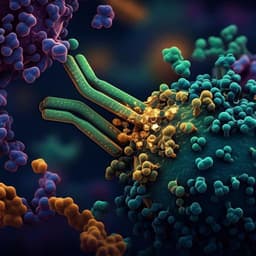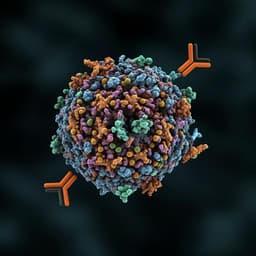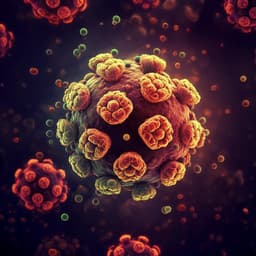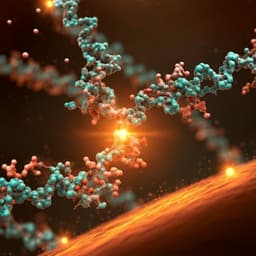
Medicine and Health
A cross-reactive human IgA monoclonal antibody blocks SARS-CoV-2 spike-ACE2 interaction
M. Ejeme, Q. Li, et al.
This groundbreaking research unveils MAb362, a cross-reactive human IgA monoclonal antibody that tackles both SARS-CoV and SARS-CoV-2 spike proteins, effectively blocking ACE2 receptor binding. With the potential to neutralize SARS-CoV-2, this study suggests that specific IgA antibodies could be key in boosting mucosal immunity. Conducted by a team of experts, including Monir Ejeme and Qi Li, this work sheds light on new avenues for COVID-19 defense.
~3 min • Beginner • English
Introduction
SARS-CoV-2 emerged in late 2019 and rapidly spread worldwide, causing the COVID-19 pandemic. The virus shares approximately 79.6% sequence identity with SARS-CoV and uses the human ACE2 receptor for cell entry, similar to SARS-CoV. Neutralizing monoclonal antibodies (mAbs) targeting the spike (S) glycoprotein—especially the receptor-binding domain (RBD)—are promising countermeasures for prophylaxis or therapy. However, concerns about antibody-dependent enhancement (ADE) and the unclear role of antibody isotypes, particularly IgA versus IgG, in mucosal protection remain. Given that mucosal IgA can be multimeric and abundant at the respiratory epithelium, and that prior work indicates antibodies that block RBD–ACE2 interactions can prevent infection, this study set out to identify and characterize a cross-reactive human IgA monoclonal antibody capable of blocking ACE2 binding and neutralizing SARS-CoV-2, with an emphasis on understanding isotype-dependent functional differences.
Literature Review
Prior studies demonstrated feasibility of anti-coronavirus mAbs targeting the spike protein to neutralize SARS-CoV and related coronaviruses, with many effective antibodies binding epitopes on the RBD and blocking ACE2 engagement. Reports also highlighted potential ADE concerns from vaccines or antibodies. Comparative immunology suggests IgA can exhibit enhanced avidity and mucosal activity due to its multimeric forms, with precedents from other viruses such as influenza and HIV showing isotype-dependent differences in neutralization breadth and potency. Recent structural studies mapped RBD epitopes and antibody binding modes for SARS-CoV and SARS-CoV-2, including antibodies that neutralize without directly blocking ACE2, underscoring diversity of mechanisms and the importance of epitope location relative to the ACE2 interface.
Methodology
- Antibody source and selection: A previously developed panel of human mAbs against the SARS-CoV RBD was generated from transgenic mice expressing human immunoglobulin genes. Mice were immunized weekly for 6–8 weeks with SARS-CoV spike protein plus adjuvant, followed by standard hybridoma fusion and selection. Archived hybridomas (>36) were recovered and screened by ELISA for cross-reactivity to SARS-CoV-2 spike and RBD, identifying MAb362.
- Isotype engineering and expression: Variable regions of MAb362 were cloned into expression vectors to generate IgG, monomeric IgA, dimeric IgA (dIgA; via co-expression with J chain), and secretory IgA (sIgA; via co-expression with J chain and secretory component). Constructs were expressed in Expi293 cells and purified (protein A for IgG; appropriate resins for IgA isotypes).
- Binding assays: ELISAs assessed binding of MAb362 isotypes to SARS-CoV and SARS-CoV-2 S1 and RBD constructs. Biolayer interferometry (BLI) was used to determine kinetic parameters and affinities for MAb362 IgG and IgA binding to the SARS-CoV-2 RBD.
- Receptor-blocking assay: A flow cytometry-based assay using Vero E6 cells measured inhibition of Myc-tagged SARS-CoV-2 S/RBD binding by MAb362 IgG and IgA across concentrations (approximately 2–2000 nM), determining concentration-dependent blockade relative to controls.
- Mutational scanning: Alanine, tryptophan, and lysine substitutions were introduced into RBD to probe the MAb362 epitope. Recombinant mutant RBDs were tested by ELISA to quantify shifts in EC50 relative to wild type, identifying residues critical for binding and overlap with the ACE2 interface.
- Structural modeling: Protein–protein docking of MAb362 onto the SARS-CoV-2 RBD guided by mutational data was performed using Schrödinger software and refined by molecular dynamics simulations (Desmond). Models were compared with known ACE2–RBD structures and other antibody–RBD complexes to map epitope overlap and accessibility in spike conformational states.
- Pseudovirus neutralization: Lentiviral pseudoviruses bearing SARS-CoV or SARS-CoV-2 spikes were incubated with serial dilutions of MAb362 isotypes and used to infect HEK293T cells expressing ACE2. Neutralization was quantified via luciferase readout to generate IC50 values.
- Live virus neutralization: Plaque reduction neutralization tests (PRNT) using live SARS-CoV-2 (Vero E6 cells) were conducted with serially diluted antibodies to determine IC50/endpoint titers, comparing isotypes, with statistical analyses performed using standard methods (e.g., Spearman–Kärber).
Key Findings
- Cross-reactivity and binding: MAb362 binds both SARS-CoV and SARS-CoV-2 RBDs and S1 proteins. IgA displayed stronger binding to the SARS-CoV-2 RBD than IgG, with substantially slower dissociation kinetics. Reported affinity values included an IgA Kd of approximately 0.3 nM versus 13 nM for IgG; in additional measurements, IgA showed Kd around 0.17 nM.
- ACE2-blocking activity: Both MAb362 IgG and IgA inhibited SARS-CoV-2 RBD binding to Vero E6 cells in a concentration-dependent manner, with inhibition evident above roughly 30 nM.
- Epitope mapping: Mutational scanning identified residues F456A, A475V, Y489A, Q493W, Y494, and Y495A as critical for MAb362 binding, consistent with overlap of the ACE2-binding interface. Some lysine substitutions had minimal or enhancing effects, suggesting charge-favorable interactions. Mutations A475V and Y489A also impaired ACE2 binding.
- Structural modeling: The modeled MAb362 epitope on the SARS-CoV-2 RBD overlaps the ACE2-contact surface and differs from epitopes of several reported neutralizing antibodies (e.g., CR3022, REGN10933/REGN10987). The epitope is accessible when the spike RBD is in the open (up) conformation, aligning with the observed neutralization mechanism.
- Neutralization potency (pseudovirus): Both isotypes neutralized SARS-CoV pseudovirus. For SARS-CoV-2 pseudovirus, IgA exhibited enhanced potency versus IgG. Reported IC50 values included monomeric IgA ~1.26 mg mL−1 versus IgG ~5.867 mg mL−1. Multimeric forms were markedly more potent: dIgA IC50 ~30 ng mL−1 and sIgA IC50 ~10 ng mL−1.
- Neutralization of authentic virus: MAb362 IgA neutralized live SARS-CoV-2 with an IC50 of approximately 9.54 μg mL−1, whereas MAb362 IgG did not neutralize at the highest tested concentration.
- Isotype effect: Switching to the IgA isotype (including dimeric and secretory forms) significantly enhanced neutralization of SARS-CoV-2 compared with IgG despite shared variable regions, underscoring the functional importance of the IgA constant region and multimerization.
Discussion
The study demonstrates that MAb362 targets a conserved epitope overlapping the ACE2-binding site on the RBD of SARS-CoV and SARS-CoV-2, directly blocking receptor engagement and thereby neutralizing viral entry. Despite similar variable regions and ACE2-blocking activity, IgA isotypes—especially dimeric and secretory forms—exhibited substantially greater neutralization potency than IgG against SARS-CoV-2. Structural considerations likely explain this: the longer, flexible hinge of IgA1 can reduce steric hindrance and permit simultaneous engagement of multiple RBDs in the trimeric spike’s open conformation, increasing avidity and functional blockade. These findings align with known advantages of IgA in mucosal environments, where secretory IgA is stabilized by the secretory component and concentrated at epithelial surfaces. Collectively, the data suggest IgA-based antibodies could play an independent and critical role in protective mucosal immunity against SARS-CoV-2 and highlight epitope accessibility and isotype architecture as key determinants of neutralization efficacy.
Conclusion
The study identifies and characterizes MAb362, a human IgA monoclonal antibody that cross-reacts with SARS-CoV and SARS-CoV-2, overlaps the ACE2-binding epitope on the RBD, blocks receptor engagement, and potently neutralizes SARS-CoV-2—particularly in dimeric and secretory IgA forms. The work underscores the importance of isotype in antiviral activity and supports development of IgA-based immunoprophylaxis or therapeutics to elicit or deliver mucosal immunity in the respiratory tract. Future research should evaluate in vivo efficacy and protection at mucosal sites, optimize dosing and delivery routes for secretory IgA, and assess breadth against emerging variants while further defining structural correlates of enhanced neutralization.
Limitations
The experiments were primarily in vitro, including ELISA, BLI, receptor-blocking, structural modeling, and pseudovirus/live-virus neutralization in cell culture; in vivo efficacy and mucosal protection were not assessed. Some methodological descriptions are limited, and reported potency values vary by assay format and isotype (e.g., monomeric versus multimeric IgA), which may affect direct comparability. Structural conclusions rely on modeling supported by mutational mapping rather than a co-crystal structure of MAb362 with RBD.
Related Publications
Explore these studies to deepen your understanding of the subject.







